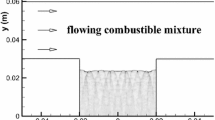Abstract
The phenomenon that occurs when a Chapman–Jouguet (CJ) detonation collides with a shock wave is discussed. Assuming a one-dimensional steady wave configuration analogous to a planar shock–shock frontal interaction, analytical solutions of the Rankine–Hugoniot relationships for the transmitted detonation and the transmitted shock are obtained by matching the pressure and particle velocity at the contact surface. The analytical results indicate that there exist three possible regions of solutions, i.e. the transmitted detonation can have either strong, weak or CJ solution, depending on the incident detonation and shock strengths. On the other hand, if we impose the transmitted detonation to have a CJ solution followed by a rarefaction fan, the boundary conditions are also satisfied at the contact surface. The existence of these multiple solutions is verified by an experimental investigation. It is found that the experimental results agree well with those predicted by the second wave interaction model and that the transmitted detonation is a CJ detonation. Unsteady numerical simulations of the reactive Euler equations with both simple one-step Arrhenius kinetic and chain-branching kinetic models are also carried out to look at the transient phenomena and at the influence of a finite reaction thickness of a detonation wave on the problem of head-on collision with a shock. From all the computational results, a relaxation process consisting of a quasi-steady period and an overshoot for the transmitted detonation subsequent to the head-on collisions can be observed, followed by the asymptotic decay to a CJ detonation as predicted theoretically. For unstable pulsating detonations, it is found that, due to the increase in the thermodynamic state of the reactive mixture caused by the shock, the transmitted pulsating detonation can become more stable with smaller amplitude and period oscillation. These observations are in good agreement with experimental evidence obtained from smoked foils where there is a significant decrease in the detonation cell size after a region of relaxation when the detonation collides head-on with a shock wave.
Similar content being viewed by others
References
Fickett, W., Davis, W.C.Detonation. University of California Press, Berkeley (1979)
Lee J.H.S. (2001). Detonation waves in gaseous explosives. In: Ben-Dor G., Igra O., Elperin T. (eds). Handbook of Shock Waves, Vol. III, Academic, New York, pp. 309–415
Terao, K., Yoshida, T., Kishi, K., Ishii, K. Interaction between shock and detonation waves. In:CD-Rom Proceedings of 18th International Colloquium on the Dynamics of Explosions and Reactive Systems, Seattle, USA (2001)
Frank, W.J. Interaction of a Shock Wave with a Wire Screen. University of. Toronto Inst. Aerophysics UTIA Technical Notes, No. 13.(1957)
Oppenheim A.K., Urtiew P.A., Stern R.A. (1959) Peculiarity of shock impingement on area convergence. Phys. Fluids 2(4): 427–431
Reynolds, W.C. The Element Potential Method for Chemical Equilibrium Analysis: Implementation in the Interactive Program STANJAN, 3rd ed. Mechanical Engineering Department, Stanford University(1986)
Oran E.S., DeVore C.R. (1994) The stability of imploding detonations: results of numerical simulations. Phys. Fluids 6(1): 369–380
Short M., Sharpe G.J. (2003) Pulsating instability of detonations with a two-step chain-branching reaction model: theory and numerics. Combust. Theory Modelling 7, 401–416
Toro E.F. (1999) Riemann Solvers and Numerical Methods for Fluids Dynamics, 2nd edi. Springer, Berlin Heidelberg New York
Ng H.D. (2005) The Effect of Chemical Reaction Kinetics on the Structure of Gaseous Detonations. Ph.D. Thesis, McGill University, Montreal, Canada
Berger M.J., Oliger J. (1984) Adaptive mesh refinement for hyperbolic partial differential equations. J. Comput. Phys. 53, 484–512
Ng H.D., Lee J.H.S. (2003) Direct initiation of detonation with a multi-step reaction scheme. J. Fluid Mech. 476, 179–211
Lee H.I., Stewart D.S. (1990) Calculation of linear detonation instability: one-dimensional instability of planar detonations. J. Fluid Mech. 216, 103–132
Konnov, A.A. Detailed reaction mechanism for small hydrocarbons combustion. Release 0.4, http://homepages.vub.ac.be/~akonnov/ (1998)
Botros, B.B., Zhu, Y.J., Ng, H.D., Lee, J.H.S. The unsteady dynamics of the head-on collision between a detonation and a shock wave. In: CD-Rom Proceedings of 20th International Colloquium on the Dynamics of Explosions and Reactive Systems, Montreal, Canada (2005)
Author information
Authors and Affiliations
Corresponding author
Additional information
Communicated by K. Takayama.
Rights and permissions
About this article
Cite this article
Ng, H.D., Botros, B.B., Chao, J. et al. Head-on Collision of a Detonation with a Planar Shock Wave. Shock Waves 15, 341–352 (2006). https://doi.org/10.1007/s00193-006-0022-5
Received:
Accepted:
Published:
Issue Date:
DOI: https://doi.org/10.1007/s00193-006-0022-5



